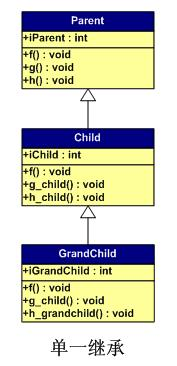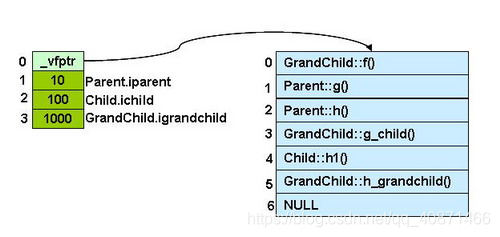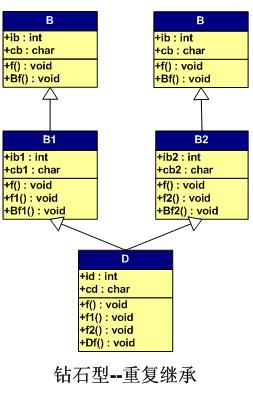关于C++对象布局 看了大佬的博客,大佬的博客过于久远格式比较清奇,我整理了,顺便改了程序能够在 64位机运行。
单一的一般继承

通俗的讲,一层层下去。
#include<iostream>
using namespace std;
class Parent
{
public:
long iparent;//因为是64位机,所以改成了 long
Parent() : iparent(10) {}
virtual void f() { cout << " Parent::f()" << endl; }
virtual void g() { cout << " Parent::g()" << endl; }
virtual void h() { cout << " Parent::h()" << endl; }
};
class Child : public Parent
{
public:
long ichild;
Child() : ichild(100) {}
virtual void f() { cout << "Child::f()" << endl; }
virtual void g_child() { cout << "Child::g_child()" << endl; }
virtual void h_child() { cout << "Child::h_child()" << endl; }
};
class GrandChild : public Child
{
public:
long igrandchild;
GrandChild() : igrandchild(1000) {}
virtual void f() { cout << "GrandChild::f()" << endl; }
virtual void g_child() { cout << "GrandChild::g_child()" << endl; }
virtual void h_grandchild() { cout << "GrandChild::h_grandchild()" << endl; }
};
typedef void (*Fun)(void);
int main()
{
GrandChild gc;
long **pVtab = (long **)&gc;
Fun pFun;
cout << "[0] GrandChild::_vptr->" << endl;
for (int i = 0; (Fun)pVtab[0][i] != NULL; i += 2)
{
pFun = (Fun)pVtab[0][i];
cout << " [" << i << "] ";
pFun();
}
printf("start offet:%llx\n", pVtab);
cout << "[1] Parent.iparent = " << (long)((pVtab[1])) << endl;
cout << "[2] Child.ichild = " << (long)(pVtab[2]) << endl;
cout << "[3] GrandChild.igrandchild = " << (long)(pVtab[3]) << endl;
}
输出结果
[0] GrandChild::_vptr->
[0] GrandChild::f()
[2] Parent::h()
[4] Child::h_child()
start offet:7ffee4956f80
[1] Parent.iparent = 10
[2] Child.ichild = 100
[3] GrandChild.igrandchild = 1000

顺便我们用gdb 看一下。
GNU gdb (Debian 7.12-6) 7.12.0.20161007-git
list
40 {
41 pFun = (Fun)pVtab[0][i];
42 cout << " [" << i << "] ";
43 pFun();
44 }
45 printf("start offet:%llx\n", pVtab);
46 cout << "[1] Parent.iparent = " << (long)((pVtab[1])) << endl;
47 cout << "[2] Child.ichild = " << (long)(pVtab[2]) << endl;
48 cout << "[3] GrandChild.igrandchild = " << (long)(pVtab[3]) << endl;
49 }
p pVtab
$1 = (long **) 0x7fffffffcb90
x /10xg 0x7fffffffcb90
0x7fffffffcb90: 0x0000555555755ce0(你可以继续找下去可以找到具体函数地址) 0x000000000000000a(10)
0x7fffffffcba0: 0x0000000000000064(100) 0x00000000000003e8(1000)
0x7fffffffcbb0: 0x000000000000008e 0x000055555555509a
0x7fffffffcbc0: 0x00007fffffffcb90 0x0000000655554bf0
0x7fffffffcbd0: 0x00007fffffffccc0 0x0000000000000000
多重继承

#include<iostream>
using namespace std;
class Base1
{
public:
long ibase1;
Base1() : ibase1(0x10) {}
virtual void f() { cout << "Base1::f()" << endl; }
virtual void g() { cout << "Base1::g()" << endl; }
virtual void h() { cout << "Base1::h()" << endl; }
};
class Base2
{
public:
long ibase2;
Base2() : ibase2(0x20) {}
virtual void f() { cout << "Base2::f()" << endl; }
virtual void g() { cout << "Base2::g()" << endl; }
virtual void h() { cout << "Base2::h()" << endl; }
};
class Base3
{
public:
long ibase3;
Base3() : ibase3(0x30) {}
virtual void f() { cout << "Base3::f()" << endl; }
virtual void g() { cout << "Base3::g()" << endl; }
virtual void h() { cout << "Base3::h()" << endl; }
};
class Derive : public Base1,
public Base2,
public Base3
{
public:
long iderive;
Derive() : iderive(0x100) {}
virtual void f() { cout << "Derive::f()" << endl; }
virtual void g1() { cout << "Derive::g1()" << endl; }
};
typedef void (*Fun)(void);
int main()
{
Derive d;
long **pVtab = (long **)&d;
Fun pFun;
cout<<hex;
cout << "[0] Base1::_vptr->" << endl;
pFun = (Fun)pVtab[0][0];
cout << " [0] ";
pFun();
pFun = (Fun)pVtab[0][1];
cout << " [1] ";
pFun();
pFun = (Fun)pVtab[0][2];
cout << " [2] ";
pFun();
pFun = (Fun)pVtab[0][3];
cout << " [3] ";
pFun();
pFun = (Fun)pVtab[0][4];
cout << " [4] ";
cout << pFun << endl;
cout << "[1] Base1.ibase1 = " << (long)(pVtab[1]) << endl;
long s = sizeof(Base1) / 8;
cout << "[" << s << "] Base2::_vptr->" << endl;
pFun = (Fun)pVtab[s][0];
cout << " [0] ";
pFun();
cout << " [1] ";
pFun=(Fun)pVtab[s][1];
pFun();
pFun = (Fun)pVtab[s][2];
cout << " [2] ";
pFun();
pFun = (Fun)pVtab[s][3];
cout << " [3] ";
cout << pFun << endl;
cout << "[" << s + 1 << "] Base2.ibase2 = " << (long)(pVtab[s + 1]) << endl;
s = s + sizeof(Base2) / 8;
cout << "[" << s << "] Base3::_vptr->" << endl;
pFun = (Fun)pVtab[s][0];
cout << " [0] ";
pFun();
pFun = (Fun)pVtab[s][1];
cout << " [1] ";
pFun();
pFun = (Fun)pVtab[s][2];
cout << " [2] ";
pFun();
pFun = (Fun)pVtab[s][3];
cout << " [3] ";
cout << pFun << endl;
s++;
cout << "[" << s << "] Base3.ibase3 = " << (long)pVtab[s] << endl;
s++;
cout << "[" << s << "] Derive.iderive = " << (long)pVtab[s] << endl;
}
运行结果
[0] Base1::_vptr->
[0] Derive::f()
[1] Base1::g()
[2] Base1::h()
[3] Derive::g1()
[4] 1//这个表示最后一个
[1] Base1.ibase1 = 10
[2] Base2::_vptr->
[0] Derive::f()
[1] Base2::g()
[2] Base2::h()
[3] 1
[3] Base2.ibase2 = 20
[4] Base3::_vptr->
[0] Derive::f()
[1] Base3::g()
[2] Base3::h()
[3] 0
[5] Base3.ibase3 = 30
[6] Derive.iderive = 100
用GDB看看
-exec p pVtab
$1 = (long **) 0x7fffffffcb80
-exec x /10xg 0x7fffffffcb80
0x7fffffffcb80: 0x0000555555756c50 0x0000000000000010
0x7fffffffcb90: 0x0000555555756c80 0x0000000000000020
0x7fffffffcba0: 0x0000555555756ca8 0x0000000000000030
0x7fffffffcbb0: 0x0000000000000100 0x0000000000000000
0x7fffffffcbc0: 0x000055555555583e 0x00007fffffffcb80
-exec x /10xg 0x0000555555756c50
0x555555756c50 <_ZTV6Derive+16>: 0x000055555555583e 0x00005555555555be
0x555555756c60 <_ZTV6Derive+32>: 0x00005555555555f6 0x0000555555555882
0x555555756c70 <_ZTV6Derive+48>: 0xfffffffffffffff0 0x0000555555756d38
0x555555756c80 <_ZTV6Derive+64>: 0x000055555555587b 0x000055555555568c
0x555555756c90 <_ZTV6Derive+80>: 0x00005555555556c4 0xffffffffffffffe0
-exec x /10xg 0x000055555555583e (不知道为啥其他查看其他几个虚表,和这个值不一样,但是也指向这个函数)
0x55555555583e <Derive::f()>: 0x10ec8348e5894855 0x57358d48f87d8948
0x55555555584e <Derive::f()+16>: 0x18083d8d48000001 0x48fffff453e80020
0x55555555585e <Derive::f()+32>: 0x201791058b48c289 0xe8d78948c6894800
0x55555555586e <Derive::f()+48>: 0x48c3c990fffff45e 0xef8348c3eb20ef83
0x55555555587e <_ZThn16_N6Derive1fEv+3>: 0xe589485590bdeb10 0xf87d894810ec8348

重复继承

#include <iostream>
using namespace std;
class B
{
public:
long ib;
char cb;
public:
B() : ib(0), cb('B')
{
}
virtual void
f()
{
cout << "B::f()" << endl;
}
virtual void Bf() { cout << "B::Bf()" << endl; }
};
class B1 : public B
{
public:
long ib1;
char cb1;
public:
B1() : ib1(11), cb1('1')
{
}
virtual void
f()
{
cout << "B1::f()" << endl;
}
virtual void f1() { cout << "B1::f1()" << endl; }
virtual void Bf1() { cout << "B1::Bf1()" << endl; }
};
class B2 : public B
{
public:
long ib2;
char cb2;
public:
B2() : ib2(12), cb2('2')
{
}
virtual void
f()
{
cout << "B2::f()" << endl;
}
virtual void f2() { cout << "B2::f2()" << endl; }
virtual void Bf2() { cout << "B2::Bf2()" << endl; }
};
class D : public B1,
public B2
{
public:
long id;
char cd;
public:
D() : id(100), cd('D')
{
}
virtual void
f()
{
cout << "D::f()" << endl;
}
virtual void f1() { cout << "D::f1()" << endl; }
virtual void f2() { cout << "D::f2()" << endl; }
virtual void Df() { cout << "D::Df()" << endl; }
};
typedef void (*Fun)(void);
int main()
{
long **pVtab = NULL;
Fun pFun = NULL;
D d;
pVtab = (long **)&d;
cout << "[0] D::B1::_vptr->" << endl;
pFun = (Fun)pVtab[0][0];
cout << " [0] ";
pFun();
pFun = (Fun)pVtab[0][1];
cout << " [1] ";
pFun();
pFun = (Fun)pVtab[0][2];
cout << " [2] ";
pFun();
pFun = (Fun)pVtab[0][3];
cout << " [3] ";
pFun();
pFun = (Fun)pVtab[0][4];
cout << " [4] ";
pFun();
pFun = (Fun)pVtab[0][5];
cout << " [5] 0x" << pFun << endl;
cout << "[1] B::ib = " << (long)pVtab[1] << endl;
cout << "[2] B::cb = " << static_cast<char>((long)(pVtab[2])) << endl;
cout << "[3] B1::ib1 = " << (long)pVtab[3] << endl;
cout << "[4] B1::cb1 = " << (static_cast<char>((long)(pVtab[4]))) << endl;
cout
<< "[5] D::B2::_vptr->" << endl;
pFun = (Fun)pVtab[5][0];
cout << " [0] ";
pFun();
pFun = (Fun)pVtab[5][1];
cout << " [1] ";
pFun();
pFun = (Fun)pVtab[5][2];
cout << " [2] ";
pFun();
pFun = (Fun)pVtab[5][3];
cout << " [3] ";
pFun();
pFun = (Fun)pVtab[5][4];
cout << " [4] 0x" << pFun << endl;
cout << "[6] B::ib = " << (long)pVtab[6] << endl;
cout << "[7] B::cb = " << (static_cast<char>((long)pVtab[7])) << endl;
cout << "[8] B2::ib2 = " << (long)pVtab[8] << endl;
cout << "[9] B2::cb2 = " << (static_cast<char>((long)pVtab[9])) << endl;
cout << "[10] D::id = " << (long)pVtab[10] << endl;
cout << "[11] D::cd = " << (static_cast<char>((long)pVtab[11])) << endl;
}
输出结果
[0] D::B1::_vptr->
[0] D::f()
[1] B::Bf()
[2] D::f1()
[3] B1::Bf1()
[4] D::f2()
[5] 0x1
[1] B::ib = 0
[2] B::cb = B
[3] B1::ib1 = 11
[4] B1::cb1 = 1
[5] D::B2::_vptr->
[0] D::f()
[1] B::Bf()
[2] D::f2()
[3] B2::Bf2()
[4] 0x0
[6] B::ib = 0
[7] B::cb = B
[8] B2::ib2 = 12
[9] B2::cb2 = 2
[10] D::id = 100
[11] D::cd = D
GDB调试
x /12x 0x7fffffffcb60
0x7fffffffcb60: 0x0000555555756c58 0x0000000000000123
0x7fffffffcb70: 0x0000555555756c55 0x0000000000000111
0x7fffffffcb80: 0x0000000000000011 0x0000555555756c98
0x7fffffffcb90: 0x0000000000000123 0x0000555555555555
0x7fffffffcba0: 0x0000000000000212 0x0000555555555a22
0x7fffffffcbb0: 0x0000000000000100 0x0000000000000033
虚拟继承
大佬偷懒了,那我们完了啊。
对于这个虚拟继承,和64位机好像有点不一样,我也不知道为啥。
如果有人看懂了回来私信我(留个言也行)。告诉我为啥。
我贴一个自己的实验。不保证正确性。





















 4013
4013











 被折叠的 条评论
为什么被折叠?
被折叠的 条评论
为什么被折叠?








